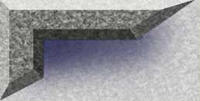|
European Theatre of Operations
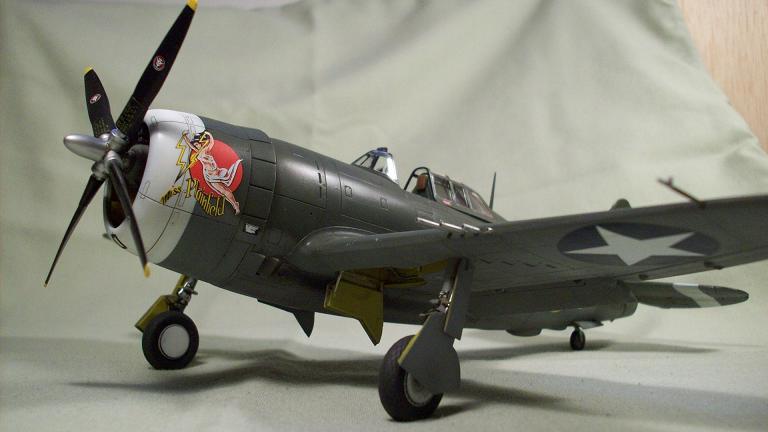
Given their origins in the Eagle Squadrons, I think it appropriate to start
this page with a plane from the 4th Fighter Group. This is Hasegawa's 1/48th P-47D Thunderbolt in the markings of "Miss Plainfield",
flown by Spiros "Steve" Pisanos. The plumbing keel was sanded down and the lines rescribed to reflect the appearance of this
early P-47 prior to the introduction of drop tanks. This model was built using
True Details wheels and certain parts from their cockpit set, Kendall flaps, and a bit of wiring and other spare photoetch
bits. Decals are from Lifelike and performed wonderfully in application. The paints used are from Floquil, Humbrol, and
White Ensign Models.
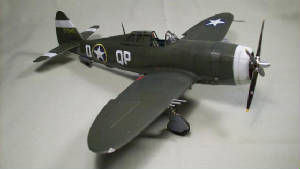
His biography is the story of a quintessential American journey. Born in
Greece with no opportunity to fly in the Royal Hellenic Air Force, he immigrated to the United States and worked various jobs
while paying for private flying school. On the outbreak of WWII, he volunteered to fly with the Eagle
Squadrons and was interviwed and accepted for training by the Clayton Knight Commitee. His lifelong dream to become a fighter
pilot was fulfilled.
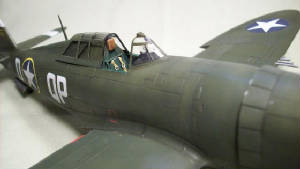
When the Eagle Squadrons were absorbed into the the U.S. Army Air Corps
his Group Commander, Col. Don Blakeslee, arranged for a representative of the state department to come to Debden and perform
a ceremony to have Steve sworn in as a U.S. citizen. He was the first person ever to become a naturalized U.S. citizen while
stationed or residing outside the country. Steve Pisanos retired from the USAF as a Colonel, after a long career as a fighter
pilot and WWII ace, test pilot, and command pilot in Vietnam.
Below, another Hasegawa P-47D, in the markings of Capt. Walter Beckham
of the 353rd FG, based at Metfield. Beckham began his tour when the P-47 was still hampered by an operational radius too short
to accompany bombers into Germany. Those difficulties were solved with additoinal fuel plumbing and addition of drop tanks.
He achieved 18 victories, three of which were tallied on the Muenster Raid, October 10, 1943. Decals by Superscale.

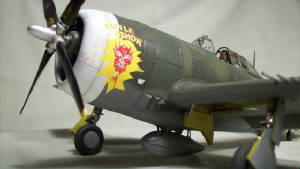
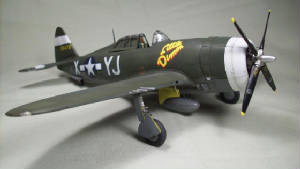
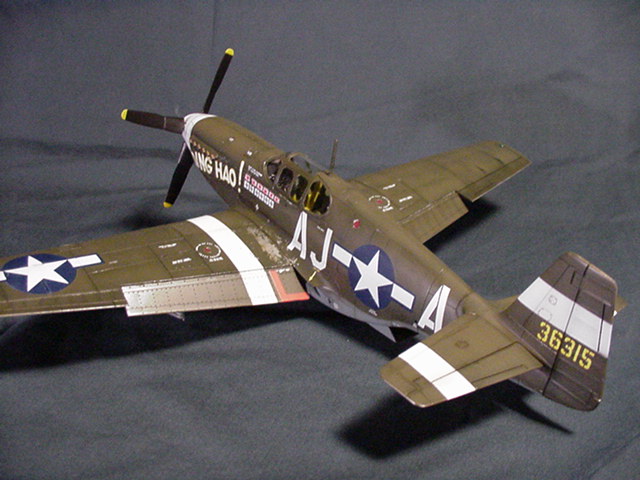
|
| I used the CAM decals on this one, they appear to be about 10% oversized |
Above and below: Tamiya's 1/48th scale P-51B Mustang in the markings
of Maj. James H. Howard, 356th FS/354th FG, based at Duxford in the spring of 1944. The japanese flags represent victories
with which Howard was credited while flying P-40 Tomahawks with the American Volunteer Group in China. The only ETO
fighter pilot to be awarded the Congressional Medal of Honor in World War II, he used this aircraft to single-handedly defend
a box of B-17's from a large formation of Bf110G heavy fighters near Oschersleben. Even after his ammunition was exhausted
he continued to feign aggressive attacks on the german fighters in order to foil their attacks in an action reported by 100's
of bomber crewman who witnessed the event.
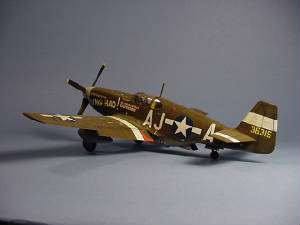
In the spring of 1944 the universal white recognition markings were abandoned in favor of assigned group color themes...

Above and below: Capt. Robert Johnson's P-47D of the 56th
Fighter Group, christened "Lucky II" as it appeared in the late spring of 1944. Hasegawa kit with Aeromaster decals,
paints are Floquil Military Flats Olive Drab and Neutral Gray and British Scarlet mixed 2:1 with Modelmaster Insignia
Red. Johnson was the ETO's second-highest scoring American Ace, credited with 28 victories.
And then the colors and ID markings started to get really crazy with Operation Overlord...
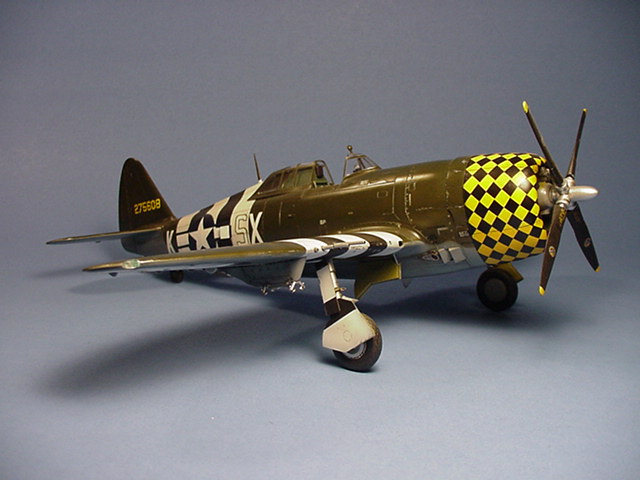
|
| This one has decals from Aeromaster and a Teknics pilot harness |
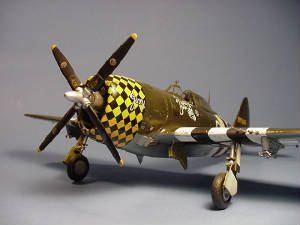
|
| Diamonds decals were sliced into rows to get a decent fit |
Hasegawa's 1/48th P-47D Thunderbolt, in the markings of Maj. William
H. Juntilla, Operations Officer of the 352nd FS/353rd FG while based at Raydon in the early summer of 1944. I've always
had a thing for the cowl pattern used by the 353rd and combined with the invasion stripes the effect against the olive drab
seems quite striking for a combat aircraft. Modelers may argue for all eternity regarding the correct color for the
quarter panel aft of the cockpit under the sliding canopy, just to be different I went with a faded dull dark green.
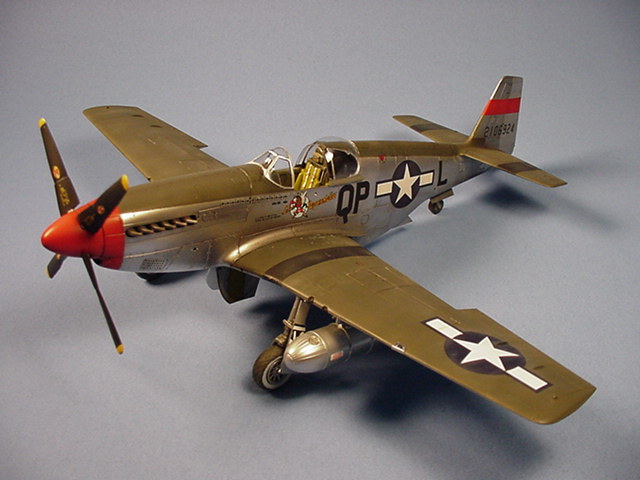
Above and below: Tamiya's P-51B Mustang in the markings of Lt. Ralph
'Kidd' Hofer, 334th FS, 4th FG. The 'Kidd' is among the most famous of 4th FG aces and had a reputation for being something
of a maverick. His tendency to overlook instructions and wage a personal war against the Luftwaffe had him standing
at attention in front of the CO's desk on a few occasions. His 15 air-to-air and 15 air-to-ground victories attest to his
flying skills and fighting spirit. Hofer was killed in action on July 2, 1944 under circumstances that are still debated by
historians today.
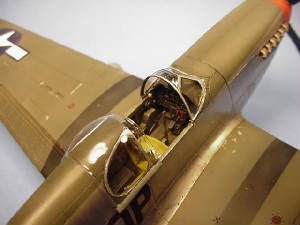
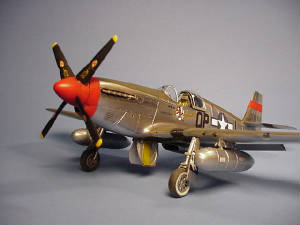
Another Tamiya kit, below, in the markings of Maj. William Jackson. Named "Hot Stuff", Jackson's Mustang
wears the blue nose of the 352nd FG and represents their transition to natural metal finishes in the late Spring of 1944.
Jackson was credited with 7 victories.
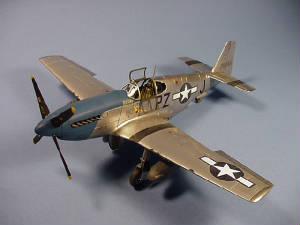
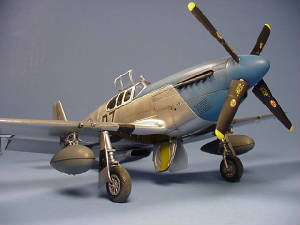
The 353rd ditched diamonds in favor of checkers when they re-equipped on Mustangs. Col. Glenn Duncan
achieved all of his 19 victories while flying P-47 Thunderbolts, but was downed over Holland on July 7th, 1944.
He evaded capture and spent several months with the Dutch Resistance before returning to England and command of the 353rd
Fighter Group. The war was only to last a few more weeks when he returned to operations flying the P-51D on April 22nd,
1945. Below we find Tamiya's P-51D painted with Alclad II lacquers and marked with Eagle Strike
decals.
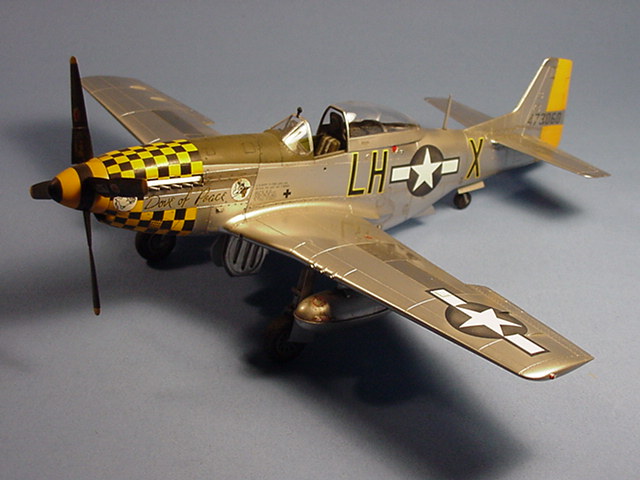
All of Duncan's aircraft bore the name "Dove of Peace". The black and yellow recognition markings
had been introduced as diamonds on the cowls of the group's P-47s in 1944, but were switched to checkers when the group transitioned
onto the P-51. Several types of mirrors were used on Mustangs, this one bearing the older RAF type, the oil stain trailing
on the fuselage from the breather line was done with artist's oils.
Below is Hasegawa's 1/48th P-51D in the markings of Capt. Wilbur
Scheible. Will was assigned to the HQ Flight of the 356th FG, 8th Fighter Command, based at Martlesham in the winter
of 1944-45. He is credited with 6 confirmed victories, but his canopy framing wore 9 crosses- that leads me to believe
that some of his claims may have been reduced to "probably destroyed" by the air combat analysis board. Pretty common instance
of armchair quarterbacking that became the rule toward the end of the war in Europe.
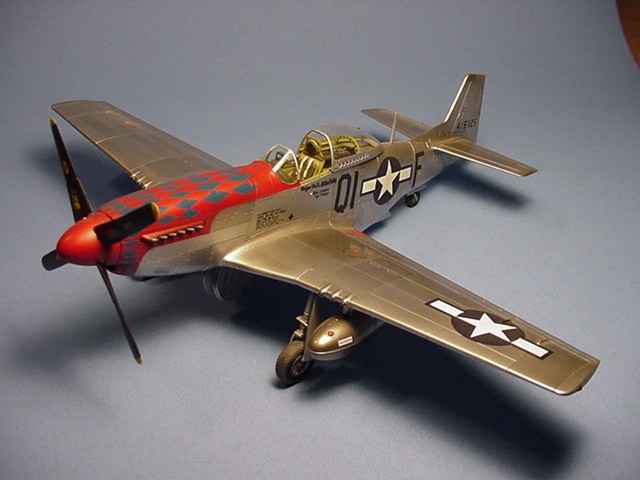
Under the Blakeslee-Doolittle
escort scheme the 356th was usually assigned to the "fixed bomber escort" role and were not permitted to chase Luftwaffe fighters
outside the periphery of the bomber boxes. As a result, the unit was restricted in it's opportunites to engage enemy
formations and almost never dropped down to strafe airfields. Other aces in the unit included Donald Strait, Clinton
Burdick, and Herb Rutland.
While discussing the color and markings of the aircraft during an
informal gathering of the NCF back in 1999, Will told me that his Mustang was the "cleanest P-51 in the entire 8th Air Force"
and in looking at my photos he may have been right. I couldn't even find evidence of exhaust or cordite staining, so
I restricted my weathering to a burnt umber panel line and interior wash. Will helped me determine the hue, brightness,
and metallic reflectivity of the red by comparing lipsticks donated by the wives present at the meeting- where
would us modelers be without the women who support our styrene neuroses? Medium blue was sprayed first, then the pattern
for the diamonds was masked off and the candy apple red was sprayed. Natural metal surfaces are Alclad II's light aluminum
oversprayed with a very light treatment of their dark aluminum and magnesium to create contrasts between certain panels.
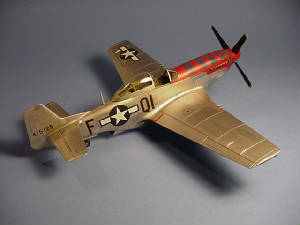
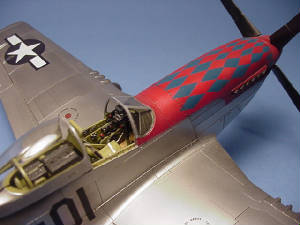
|
